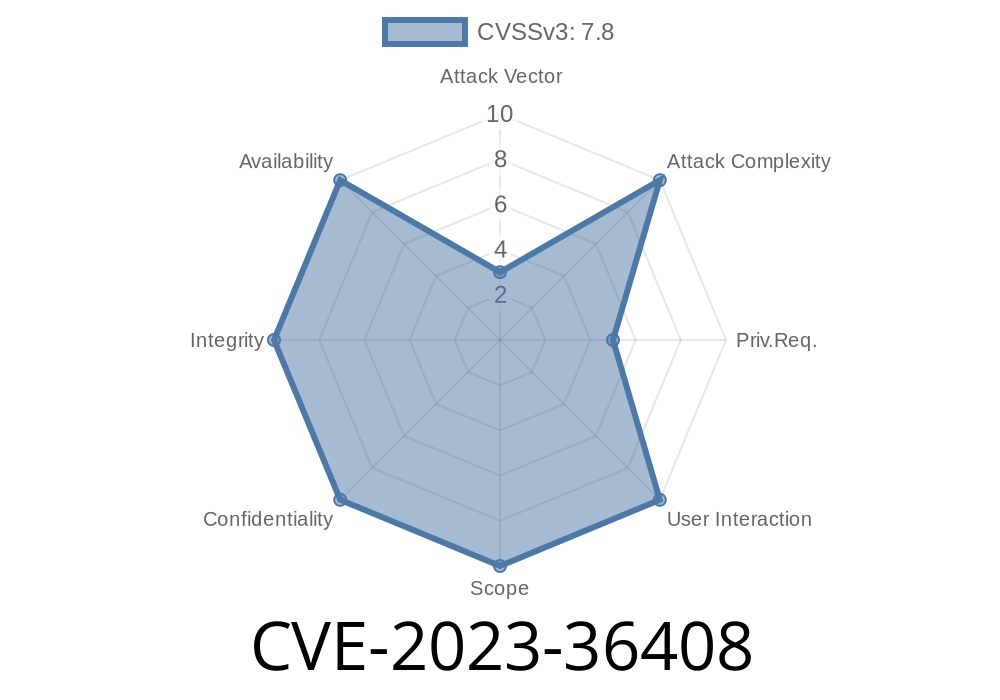When it comes to securing our computer systems, staying ahead of the latest vulnerabilities is crucial. In this post, we'll dive deep into one such vulnerability: CVE-2023-36408. This vulnerability affects Windows Hyper-V, and if exploited, could lead to an elevation of privilege, allowing potential attackers greater access to your system. We'll explore the details of this vulnerability, its implications, and what you can do to protect your systems.
CVE-2023-36408 - The Basics
CVE-2023-36408 is a vulnerability affecting the Windows Hyper-V virtualization platform. Specifically, this vulnerability lies within the Virtual Processor (VP) Save / Restore mechanism that may incorrectly validate the VP state, leading to a situation where potentially arbitrary memory writes can take place.
These arbitrary memory writes can then be used to elevate the privilege of an attacker-controlled process, allowing them to perform a range of malicious activities on the targeted system. The good news is that Microsoft has already released a security patch for CVE-2023-36408, so it's essential to apply this update to safeguard your systems from this vulnerability.
Original References
It's always wise to verify information from official sources. You can find detailed information on this vulnerability in the Microsoft Security Response Center (MSRC) at the following link: https://msrc.microsoft.com/update-guide/vulnerability/CVE-2023-36408
A detailed technical write-up on this vulnerability is available in the Zero Day Initiative (ZDI) blog post, which you can find here: https://www.zerodayinitiative.com/blog/2023/3/24/CVE-2023-36408
Code Snippet - Exploitation Example
A proof-of-concept for this exploit has not been released publicly, as it would pose a significant risk to those systems that have not been patched yet. However, an illustration of the exploitation could potentially involve injecting malicious code into the Virtual Processor (VP) Save / Restore mechanism. This might be initiated through a script similar to the following
# Sample pseudo-code illustrating possible exploit for CVE-2023-36408
def malicious_memory_injection(target_VP):
crafted_data = generate_crafted_vp_state_data()
target_VP.save_state()
target_VP.modify_state_data(crafted_data)
target_VP.restore_state()
execute_privilege_escalation(target_VP)
malicious_memory_injection(target_VP)
Please note that this is only an example and not verified exploit code. It's meant to illustrate the general idea of how an exploit for this vulnerability might be constructed.
Protecting Your Systems
The first and most crucial step in protecting your systems from CVE-2023-36408 is to apply the security patch provided by Microsoft. You can find the update details and a link to download the patch from the official Microsoft Security Response Center (MSRC) page for this vulnerability: https://msrc.microsoft.com/update-guide/vulnerability/CVE-2023-36408
Besides applying the patch, it's essential to follow best practices for securing your environment, such as:
Regularly monitoring and updating all software components in your environment.
2. Enforcing least privilege access control, ensuring that users and processes only have the minimum necessary privileges to perform their tasks.
3. Implementing robust network segmentation and proper firewall configurations to minimize the potential attack surface for threat actors.
Conclusion
CVE-2023-36408 is a critical elevation of privilege vulnerability in the Windows Hyper-V platform that could allow attackers to gain unauthorized access to sensitive information or execute malicious code on a targeted system. It's essential to understand the potential risks associated with this vulnerability and take immediate action to apply the security patch provided by Microsoft. By staying vigilant and following best practices, you can help safeguard your systems against threats posed by this and other vulnerabilities.
Timeline
Published on: 11/14/2023 18:15:43 UTC
Last modified on: 11/20/2023 20:20:31 UTC
